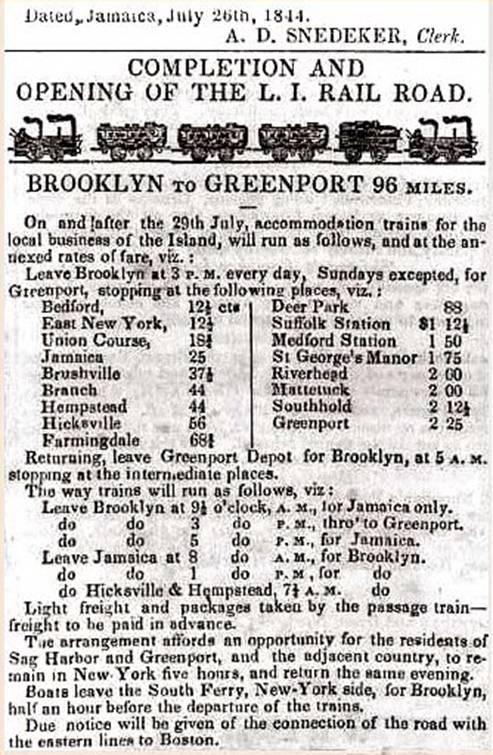A Railroad Station at Nowhere
In their Images of America Series book about Hicksville, historians Richard and Anne Evers look back to the 19th century, and they see a village which they describe as "an emerging railroad community." Those are pregnant words, for they emphasize how entwined Hicksville and the LIRR have been since their contemporaneous origins. Note: See the Appendices at the end of this article for a discussion of the relevance of the Williams land purchase to Hicksville's birth.
In the early 1830s, Valentine Hicks, a member of the Board of Directors of the new Long Island Railroad, and later the road's President, spurred the creation of a new "New York to Boston" route. It would be five hours faster than traveling all the way by water, which at that time was the quickest way. LIRR trains would take passengers to Greenport, from which LIRR ferries would deliver them to Boston. The line's investors were not interested in the railroad's serving any towns which the Greenport trains might pass along the way. They just wanted a fast, direct route, and they wouldn't pay for anything beyond that. Thus, the route to Greenport would be as straight as possible, and indifferent to any towns it happened to go near. East of Jamaica, it would go through the Hempstead Plains - flat, open, and mostly unpopulated. Curiously, there would be a few stops, perhaps made because early steam locomotives often had to replenish fuel and water, and these stops would be at obscure places like Clowesville.
***
The investors were short-sighted. They ought to have realized that the express service would keep any given stretch of track busy for only a fraction of the time. Idle tracks produce no revenue. It would make sense to introduce local service to the communities along the route, allowing their residents to travel and ship goods - except, of course, that the railroad was being built where there would be no communities along its route. Anticipating this problem,* the enterprising Mr. Hicks took advantage of it. He formed a land association to purchase undeveloped Long Island real estate. Once the railroad got going, once-useless properties could be sold at a profit, as new communities sprouted up along the line. Hicks' future looked bright indeed.
*Anticipating it, or deliberately creating it? The railroad's strategy of bypassing existing towns may have actually been an effort to enrich the members of the land association.
***
In 1836, things went sideways for a great many Americans, including Valentine Hicks. For years, Andrew Jackson had fought strenuously in Congress against the Federal government's Second Bank of the United States. As President, he ensured that the Federal bank would cease to exist in 1836.
The resulting instability had changed American banking practices, such that payments for large commercial loans often were tied to the Bank of England's lending rate. When the latter found it necessary to repeatedly increase that rate, American business, debt-laden and overstretched, could not make its loan payments. Within months, the whole country was mired in the Panic of 1837, a severe crisis that would endure for seven years. No one could get investment capital, and the railroad was forced to wind down construction.
Work on the new tracks temporarily ceased. The place where the rails ended was desolate; even the Hicksville Historical Society's web page calls it "the middle of nowhere." That was true enough, but there was something positive to be said about the spot: people passed through it a lot. Near the impromptu end of the line, the New Bridge Road met the Jerusalem-Jericho Road, as did the Massapequa Road, the combined intersections forming the distinctive birdsfoot-like pattern that long has characterized maps of the core of Hicksville:

Not a lopsided Peace Symbol, but the intersection at which Hicksville began.
This eloquent artwork created by the author.
With the connection to Greenport postponed indefinitely, the LIRR needed another source of revenue, and it changed its mind - it would introduce local service. The well-worn converging roads would keep bringing travelers right past the end of the line, and those travelers would realize that they could find the railroad useful now and then. A tiny depot was built where the track ended, with a sign that bore a brand-new name: Hicksville
Some years later, construction of the Boston connection resumed. Rail service to Greenport began in 1844, with trains stopping at intermediate towns, as shown in the timetable below. Boat service between Boston and Greenport, and special express rail service, would be introduced soon thereafter.

Yes, the U.S. once minted half-cent coins.
Wikipedia entry for LIRR
There were not many trains, a sign of how sparsely populated Long Island was. As an example, the 1830 U.S. Census indicates that the entire Township of Oyster Bay had a population of only 5,200.
***

